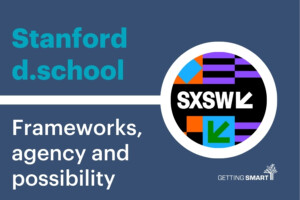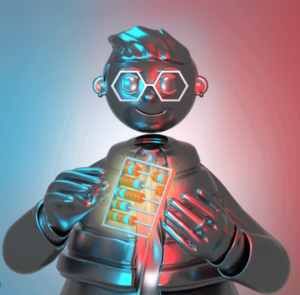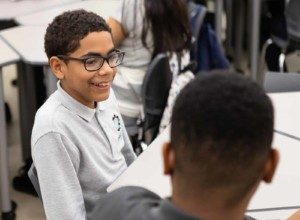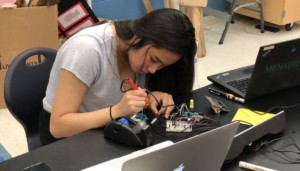How Educators Can Prepare for the Future of Work

A lot of the conversations happening today in education are focused on how we can best prepare our students for the future. What are the types of experiences that our students should have? How can we create authentic, innovative learning opportunities for students that will help them to develop the skills they might need in the future? These are probably the two most common questions that I hear and that I ask myself quite often. Besides the content that I teach, what else can I embed into the curriculum that will best prepare my students?
The answer is not clear. We cannot make accurate predictions about what the future of work or the future of learning will look like, so how can we know exactly how to prepare our students for five, ten, or more years down the road? Using the knowledge that we have now, by staying active with the discussion as it happens, and continuing to learn more about changes and trends in education, will give us the best possibilities for bringing in new ideas or resources that will help us to best prepare our students. However, I think that there is another important component that has to be part of the conversations surrounding the future of learning and the future of work, and that is how do we prepare teachers so that they can, in turn, best prepare the students?
Teaching: More Than Just Content
Being a teacher means taking on many roles besides the deliverer of content. We have many responsibilities and take on numerous roles in our schools through activities, committees, or anything that enables us to build a sense of community in our classrooms and within our schools. But one role that is equally as important as that of being a teacher is being a learner. And more importantly, being a learner for life.
It has never been more important than it is now, for educators to be in constant pursuit of knowledge and to consistently engage in different and, perhaps challenging, learning opportunities. We owe it to our students and colleagues to better ourselves so we can be prepared for whatever it is that might become part of the education landscape and the future of work.
A better question evolves from this point, and that is: What type of learning experiences and activities do educators need? How can we invest ourselves so that we are constantly learning and growing and capable of providing our students and our colleagues with exactly what they need, as they chart their path towards the uncertainty of the future? Preparing our students means preparing ourselves first. But how?
Connect and Prepare for the Future Together
The best way to prepare ourselves is to start by becoming more connected. No longer can we stay in isolation, working alone to design lessons and create learning spaces for our students. We need to connect with educators from different backgrounds and experiences. By developing a rich professional learning network (PLN), we will have the encouragement and support we need as we explore the new ideas and trends that are happening in education and the world. Setting up a network that empowers us to stay informed and relevant through crowdsourcing and conversations with members of our PLN is the first step that we must take. By doing this, we can break free from what can become an isolating profession at times.
Facing an uncertain future in the world of education and work means building the skills of adaptability, resilience, and persistence. The ability of students to build their confidence and feel comfortable and welcome in any learning environment relies on educators to establish and foster a supportive environment for them. In order for students to be able to achieve their fullest learning potential and to be more actively engaged in learning, there must be a positive and supportive teacher-student relationship created and maintained. A space that is safe, welcoming, supportive, and that faces down challenges and embraces celebrations. An opportunity to learn together and to learn in different and somewhat challenging ways.
Engage in New Learning
We need to create different learning experiences for our students, and this means that we need to break away from what may be the traditional forms of assessments and activities we are using and instead, try new ideas, resources, and even find ways to empower students to take more of a lead with the content we are teaching. We need to understand some things about our students, such as: How do they want to learn? What are their interests when it comes to learning? Why do they need to know specific content or complete a certain task? We need to become comfortable with taking less of a lead, talking openly about the methods used in the classroom, and being more of a co-learner and co-designer with students.
We must make time for ourselves to explore a passion area, whether it is something related to the content area that we teach or something that pushes us outside of our comfort zones. It’s important that we stretch ourselves professionally, so we can help our students better understand why they need to do this and how they can push through any challenges they might confront in their future. Teaching only the content that is comfortable and which we know limits the learning potential of our students. Instead, we must be open to taking risks with learning in the classroom and not knowing all of the answers to the questions that students have. We empower students more by shifting away from the role of content providers to being co-learners in our classrooms when we:
- Push for students to design their own learning paths.
- Create new opportunities for learning by asking students what they’re interested in or curious about.
- Change what we have been used to doing and instead let students become the creators and designers in the classroom.
- Ask students for ideas for the learning methods used in class.
- Work toward having students see learning as a process.
Understand the New Vocabulary
There are a lot of words being used in education today, many referred to as “buzzwords” at times. Some of the more common terms include words like personalized learning, differentiation, blended learning, student voice and student choice, SEL, and project-based learning. These are all very important concepts or strategies to implement within our classrooms today. However, as the look of education and the future of work are constantly evolving, the vocabulary related to these learning experiences is also changing.
As educators, we need to go beyond simply understanding the basic meaning of this new terminology, and instead, determine what it means in terms of how we deliver content, what steps we need to take to learn more, and how it impacts the roles that our students take. What are the opportunities that we can offer our students that align with these new education terms?
Some examples include the gig economy, generation DIY, artificial intelligence, machine learning, and entrepreneurial skills. With these new terms, students need to become the designers of their learning journeys because our knowledge will be limited in each of these areas. So what can we do? We can work to understand what these terms mean and how to create ways for students to explore them.
- Prepare students for work in a gig economy by creating opportunities for them to collaborate, plan school and community events, or design something like a product or a service for your class. Open up the possibilities for creativity and innovation and learn right along with your students. Because the estimate is that 60% of companies plan on hiring more freelancers, rather than permanent or full-time employees, our students need to build skills to be flexible and adaptable to these changes in the look of work.
- The idea behind “DIY” is to promote the setting of goals, inspire students to become curious, and engage in more meaningful work that connects more closely to their interests and offers opportunities for building self-awareness and self-assessing. Plan time for students to decide on a project, to innovate and perhaps even work as part of a small team, or be paired with a teacher-mentor, to brainstorm products, services, or any new idea that promotes problem-solving, design thinking, teamwork, and growth mindset. Working together will foster a learning community and show students that we have to be lifelong learners and that even in our role as educators, we are willing to keep learning and challenging ourselves.
- Find different uses or forms of artificial intelligence or machine learning that can be used in your classroom, especially those which help students with different class related tasks. Learning about AI, and how it likely will impact education and the world of work in the future, will benefit students and teachers for two main reasons. One, learning about it will hopefully engage students more in learning and lead them to possibly creating their own AI, or a use for AI. And two, it can lead to higher level thinking and discussions about the impact of AI and the ethics surrounding AI in education and its use in the world. With an estimate of close to 40% of the jobs being replaced by artificial intelligence in the future, we will all benefit from exploring these areas in our classrooms.
Explore Different Types of Learning
School today should focus on providing students with as many opportunities for students to explore their interests, to solve big problems, to connect globally, and to make decisions about their own learning path, including the process and product. This can be done through learning experiences such as project-based learning (PBL), place-based learning, or experiential learning. We can move away from the traditional projects and instead, consult the resources available to see how other schools are implementing these different methods and determine what the benefits are for using them.
Through project-based learning or inquiry-based learning, we can encourage students to connect with the community or even explore globally and look for problems or challenges that exist either in their local environment or in the world. PBL benefits students and teachers by focusing on critical thinking, creativity, collaboration, and problem-solving. PBL gives students the chance to design their own learning path, and it can be highly beneficial for educators to design their own PBL experience as well. When we ask students to try a new tool, use a certain method, or engage in an activity, we must also be ready to do the same.
To implement place-based learning in our classrooms, we can reach out into the community to set up experiences for our students, but the best method is perhaps to first consider the location of the school and community. Place-based learning is anytime, anywhere learning which can be influenced by location and the use of technology to provide more personalized experiences. Our students are preparing for the “real world” and they should have time to see how the world works, identify challenges that exist, and work toward finding solutions. As educators, we also need to step out of our classrooms and bring in the real world, both current and relevant issues, so our students can connect and engage in meaningful work.
Explore New Ideas
There is always something new to learn and with the availability and access to so many resources through technology, we are more capable than ever of staying informed. Here are some ways to do that:
- Read blogs or follow hashtags on social media to stay current and relevant. Explore books that are available for learning more about topics such as AI, PBL, or the future of education.
- Do some research into the top jobs or the skills most needed.
- Go back five years and look for articles and resources that made predictions for the future.
- Find articles with predictions about what the future will look like.
- Think about the skills that you are teaching students and how to continue to build your own skills to support them.
By knowing or predicting what the job market looks like, what skills our students need, and how we can help them to develop those skills, we can continue to change our methods and do more than cover content. We have a responsibility to continue learning and to connect all students with the right opportunities because they will be designing our future.
We can’t be afraid to try new ideas, especially those that stretch us professionally and enable us to experience that productive struggle that comes with learning. And most importantly, we must connect and continue to grow our learning networks, and this includes connecting and building relationships with our students. Although the summer break has arrived for many, it is a great time to explore more in these areas and prepare for the changes coming to the world of education and work.
For more, see:
- Preparing All Learners for an Uncertain Future of Work
- Learning and Growing as Educators On A Busy Schedule
- How the Micro-Credential Revolution is Transforming Professional Learning
This post is a part of the Getting Smart Future of Work Campaign. The future of work will bring new challenges and cause us to shift how we think about jobs and employability — so what does this mean for teaching and learning? In our exploration of the #FutureOfWork, sponsored by eduInnovation and powered by Getting Smart, we dive into what’s happening, what’s coming and how schools might prepare. For more, follow #futureofwork and visit our Future of Work page.
Stay in-the-know with innovations in learning by signing up for the weekly Smart Update.






0 Comments
Leave a Comment
Your email address will not be published. All fields are required.